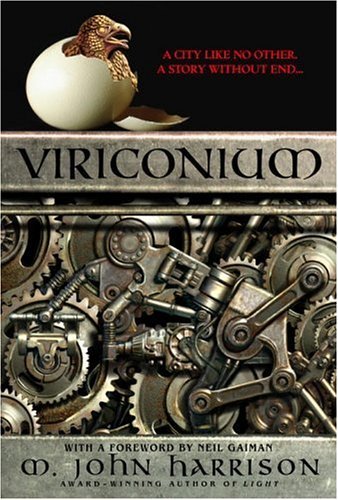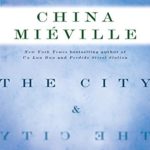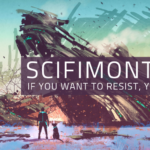The Pastel City (1971) is the first story by M. John Harrison in his Viriconium fantasy sequence. This short novel drew me in immediately with its luminous prose and its ability to depict a world in ruins and a world of hope with just a few brilliant visual strokes. Though it begins with a prologue explaining the background of the rise and fall of cultures in the “middle period of earth” and the Viriconium empire subsisting on salvage from a destroyed civilization, the novel doesn’t really need to fill you in explicitly on that background. Harrison’s selection of detail says it all.
As Neil Gaiman says in his introduction to Viriconium, a compendium on the three novels and several pieces about this fantasy world, the stories describe a changing reality, like a palimpsest that looks different each time the reader returns. The Pastel City predates the others by several years, so I’ve chosen to review it separately. I’ve seen criticisms by some readers who expect these varied stories to cohere as a single novel, but that seems unreasonable to me. I’m going to review each of the short novels on its own since each is unique.
Harrison, who has also written science fiction and “mainstream” novels as well as fantasy, often writes about characters who feel lost and alone. That is true here. The heroes of The Pastel City are a group of warriors who formed an elite force under the late king Methven but are now scattered and few in number.
The central figure is tegeus-Cromis who now lives alone in a solitary tower where he composes poetry and songs. “Cromis was a man who, like most recluses, thought he understood himself, and did not.” He is still a fighting man, though, still the finest swordsman in his world and is roused out of retirement by an invasion of barbaric Northmen who want to conquer Viriconium. Cromis is loyal to the teenage Queen Jane, Methven’s daughter. He visits her in her white castle in the Pastel City, which retains its strange beauty despite the general decay of the world around it.
“About him rose the Pastel Towers, tall and gracefully shaped to mathematical curves, tinted pale blue or fuchsia or dove-grey. They reached up for hundreds of feet, cut with quaint and complex designs that some said were the high point of an inimitable art, thought by others to be representations of the actual geometrics of Time.”
Viriconium, Kindle edition, P. 18
With the Queen’s blessing, he sets off to find a few remaining members of the old troop to join the fight against the Northern invasion. The landscape bristles with the collapsed structures of distant times and ruined industrial civilization. Its vivid metalic colors suffuse the world Cromis travels through.
“In the water thickets, the path wound tortuously between umber iron bogs, albescent quicksands of aluminum and magnesium oxides, and sumps of cuprous blue or permanganate mauve fed by slow gelid streams and fringed by silver reeds and tall black grasses.”
Viriconium, Kindle edition, P. 35
A mechanical vulture soon finds him, descends to his side and keeps repeating a strange message, that he is to turn aside from his current route and seek out a man named Cellur who warns him to beware of something called the “geteit chemosit.” Though he ignores the message, Cromis soon encounters a strange dark monstrous killing creature that steals the brains of its victims.
This alien being is a hint of the dreaded forces, allied with the army of Northmen, Cromis and his small band will have to confront. One of their number is Tomb the dwarf, a mechanical genius, who becomes a powerful war machine as he mounts an exoskeleton of his design and become a giant warrior. He is also able to master the alien technologies that the mysterious Cellur teaches him to take on the worst enemies Viriconium has ever faced.
So there is a great adventure story here, but woven through it are deeper themes about the nature of time, the shifting realities of the remnant civilizations of this strange land and always a sombre theme of human nature facing defeat and isolation.
The young queen condemns herself for having been too passive a ruler, allowing her empire to be invaded. As another character says, the queen’s defenders see only pieces of a great puzzle in darkness and may not see the whole of its meaning until it’s too late. Cromis has spent years brooding in his tower and composing songs about his strange visions.
“Strong visions: I have strong visions of this place in the empty times. . . . On the devastated peaks of hills we ease the barrenness into our thin bones like a foot into a tight shoe. . . . The narrative of this place: other than the smashed arris of the ridge there are only sad winds and silences. . . . I lay on the cairn one more rock. . . . I am possessed by Time. .”
Viriconium, Kindle edition, P. 24
But against this melancholy strain are other members of the group: the fearless Tomb, always ready to jump into any fight or good time, always pushing for the immediate thrill of contact, and Birkin Grif, the ebullient leader of a small band of fighters, ready to throw themselves into the midst of action and bursting with a kind of fatalistic optimism, even when the outcome looks dire.
And apart from the personalities of its main characters, there are hints throughout The Pastel City that there may be a way of reviving the long-buried forces that sustained the dead ancient cultures and building something more positive for the future. But this is no ordinary adventure in which a heroic figure can defeat a great villain and restore order. Whatever the future may hold, Viriconium may rise again and fall again in response to deeper forces of reality and the structures of time itself.
Despite its short length, The Pastel City contains many mysteries and beauties that repay close reading. I will come back to the other stories of Viriconium in future reviews. This series comprises a fine original classic of fantasy that is available once again after years out of print.




Leave a Reply